 |
The haddock is a popular finfish species in Atlantic Canada and Europe and interest in farming stems from the dramatic collapse of the fishery in eastern Canada and the fisheries in Europe have also been subject to intensive exploitation. Haddock have been grown commercially in New Brunswick and in a demonstration project in Scotland (sponsored by Seafish, Highlands and Islands Enterprise, Marks and Spencer, Aberdeenshire Council, Fisher Foods (now Macrae), EWOS and Mainstream).There are also broodstock fish in Norway. The life cycle and rearing process for haddock are similar to cod, but there are many detailed differences in rearing protocols.
The haddock fishery off eastern Canada collapsed in the 1980s and is taking a long period to recover, and consequently the fishery has been closed for many years. While the catches from the fishery in the North Sea declined in the 1990s due to heavy fishing the EU quota was increased in 2002 following the recruitment of several stronger year classes. The most important fisheries are the North Sea with a reported catch of 54,700 tonnes in 2006 (ICES) mainly by British boats, around the Faroe Islands with 16,800 t captured mainly by local vessels, and 97,400 t off Iceland and largely by Icelandic boats. The other main fishery is the North east Arctic off north Norway and the Barents Sea with the fishery dominated by the Norwegian catch of 69,000 t in 2006 and the Russian landings of 53,000 t. The fish in the European market are normally sold fresh on ice but in the UK many fish are smoked.
Distinguishing marks of the haddock are a black lateral line along a white side, a dark blotch above the pectoral fin, the dorsal fin is long, pointed and crescent shape, and the haddock body appearance is more slender than cod. The haddock is found at depths of 40 to 200 metres and the thermal preference is from 2° to 15°C. Haddock feed on small invertebrates such as mussels, crabs, shellfish and worms, and also consume fish. Growth rates of haddock have changed significantly over the past 30 to 40 years and presently growth is more rapid, with haddock reaching their adult size much earlier than previously reported. The growth of haddock differs between localities and by sex with female haddock generally growing faster than the males.
The main spawning grounds are off the central Norwegian coast, to the south west of Iceland and near the Faeroe Islands. Spawning occurs from January to May, peaking during late March and early April. A female of 40 cm produces approximately 300,000 eggs, and larger females are capable of producing up to 2 million eggs and these are released in a number of batches over a prolonged period. Young haddock spend the first few months of life in the upper water layers feeding on copepods and adopting a demersal habit later.
Broodstock
Farmed haddock can reach sexual maturity at two years of age, or around 750 grams, although fish in the wild may mature at 4 to 5 years old. Spawning at ambient photoperiod occurs between February and April at temperatures of 6 to 8oC. Females may spawn at different times and individuals may spawn over 15 days, with a few days’ interval between each egg batch. Brood fish can be sexed from two months before spawning using ultrasound techniques and ovaries can easily be seen in the scan as a pair of distinct lobes. Alernatively fish can be sexed by gently squeezing along the flanks immediately before spawning to see whether milt or eggs are extruded. Fish spawn spontaneously in captivity, so broodstock are allowed to spawn naturally.
Early rearing
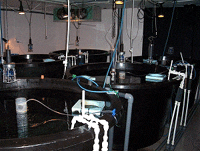 |
|
Early rearing tanks
|
Fertilised eggs are collected from the outflow of the holding tank with a 100 μm plankton net suspended in a tank of water. After disinfection and weighing, the eggs are transferred to cylindrico-conical egg incubators. On the morning following egg collection, aeration and water to the incubator are stopped permitting dead eggs to sink and the viable live eggs to float. The dead eggs are then siphoned daily to maintain incubator hygiene. The dead eggs are weighed and recorded to provide an estimate of percentage survival during incubation. The development time to hatch is temperature dependent but is normally 100 degree days.
Larval rearing
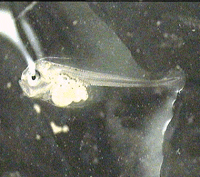 |
|
Larval stage
|
Larvae should be transferred to larval rearing tanks by gently removing by jug within 24 hours of hatch. Larval haddock are stocked into rearing tanks typically at densities of 50 to 100 larvae per litre. The rearing tank will feature a standpipe surrounded by a fine mesh to prevent escape of the larvae but permit uneaten food to be flushed out. Algae are added on the first day and daily thereafter. On day 1 post hatch (dph) enriched rotifers should also be added to give a density of ca. five rotifers per ml. Haddock larvae fill their swim bladders from the air/water interface during a critical developmental period. Therefore it is necessary to install air-powered surface skimmers on day 1 to clear the surface of oil layers associated with the live feed. Around 25 dph the first enriched Artemia should be added, in addition to rotifers. The larvae should be co-fed both Artemia and rotifers for one week, and then rotifers and algae withdrawn.
Juvenile stages
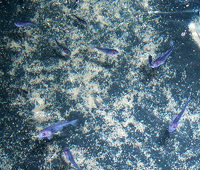 |
|
Juveniles
|
Juvenile haddock should be held in tanks until at least 5 g with stocking densities no higher than 15–20 kg/m3 to ensure fish welfare and should also be dip vaccinated against Vibrio anguillarum infection at this stage. Haddock have been transferred from the hatchery to sea cages in two stocking strategies. In the first the fish are tightly graded and transferred at c. 5 g, and then graded later at c. 50 g and vaccinated by intraperitoneal injection at sea for atypical furunculosis and Vibrio anguillarum. The alternative is to retain the juveniles in the hatchery until they are c. 20-30 g, then vaccinate and allow for a period of immune induction and then transfer the fish to sea cages. The latter plan can be more costly and difficult in terms of nursery resources in a marine hatchery. The juvenile haddock should grow to 50 g in 6 to 8 weeks, when they should be able to withstand transfer to on-growing sites. Haddock should reach a marketable size in two years.
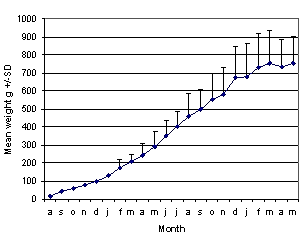
Cage on-growing
The cage type used for salmon can be utilised for rearing haddock. However, a double net is desirable to prevent chewing and escape through broken net meshes and to discourage predators. Stocking densities of up to 20 kg m-3 are appropriate for haddock. Generally no aggression is seen in haddock once they are above 5 g in weight. The growth of males and females maintained on continuous light regimes with no maturation is not significantly different. The growth of haddock with current diets is slower than cod and typical growth rates of fish are shown (Fig 1). The food conversion rate in farmed haddock is good with values in tanks and cages of around 1.
Diets
Fish can be fed by hand to satiation over c. 30 minutes. Alternatively an automatic feeding system can be used with a feed back loop, such as Aquasmart®. The diet used is standard marine diet for marine finfish species. Although these are good diets for cod the lipid content is too high for haddock and the manufacturer should be asked for special production with lipid levels as low as 10%. In practice diets with 12% lipid have been used but these are still not optimal. Haddock are less capable than cod in utilising high lipid in the diet and the lipid is not deposited in the muscle but is stored in the liver, giving the opportunity for enlarged livers. The liver weight should therefore be checked periodically by sampling a number of fish and this is expressed as a percentage of the bodyweight, the hepatosomatic index. The index can be 14% when the fish is 200 g, and 17% by 400 g. Values of over 17% may be common at the end of the second year. The liver index is not related to the size of the fish but is significantly correlated with the age of the haddock.
Maturation
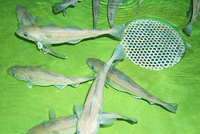 |
| Potential haddock broodstock |
Early maturation of haddock has a large effect on the growth rate, giving a loss of around 400 g in weight increment over a two year production cycle. The rate of maturation can be checked by visual inspection of the ovary or testis and the rate of development can also be checked by weighing the gonad and expressing this as a percentage of the fish body weight, the gonadosomatic index. Farmed haddock typically spawn at the end of their second year. Maturation in fish has been found to be triggered by the seasonal light regime with melatonin produced in the pituitary gland initiating a process that leads to maturation. Spawning in tanks can be retarded by the provision of continuous light from the first summer solstice but further investigations of lighting have to be done in sea cages.
Diseases
Vibrio anguillarum has been found to be the main health issue to date in farming haddock. Vibriosis is the term applied to a primary infection by a pathogenic Vibrio species and this is different from non-specific infections where a large number of secondary or opportunistic Vibrio species may be involved. Outbreaks generally in marine finfish can be associated with stress such as high stocking densities, poor environmental conditions and handling. Clinical signs are skin lesions, erosion of fins, especially the dorso-lateral fin, bloated fins, and a sudden increase in mortalities. Diagnosis is by taking a bacterial swab from fresh mortalities or from skin lesions.
Vaccines available in the UK were developed for use with salmon and the serotypes are different from those found in marine finfish and the latter are 02a and 02b, so the protection may not be as effective. Vaccines in use in Norway for cod give protection against a range of serotypes but the vaccines are not licensed for use in the UK. An alternative is for hatcheries or on-growing farms to produce individual autologous vaccines from Vibrio strains detected on their own farm.
Other potential health issues are atypical furunculosis, Aeromonas salmonicida subspecies achromogenes. The indications in haddock are internal haemorrhaging, bloody fluid in the body cavity, and sometimes external lesions. Diagnosis is by taking swabs and checking bacterial growth on agar.
Haddock as with cod can be “carriers” of IPNV without showing clinical symptoms and broodstocks collected from the wild should be quarantined and samples taken for virology testing. Cod can be susceptible to VHS so haddock may also be at risk, but no cases have been recorded in aquaculture for either species.
Parasites that have been recorded from haddock have been the protists Costia (Ichthyobodo) and Trichodina, and treatment is with formalin at 200 ppm for 30 minutes. The digenean Cryptocotyle lingua, responsible for “black spot”, can be seen as spots on the fins, head and back, and can occur in sheltered enclosed sites. Although sea lice have not been recorded as a problem with cultured haddock, the sea lice Caligus elongatus and Caligus curtus have been reported from wild haddock. The medicines available are those licensed for salmon, for example cypermethrin (Excis®, Novartis Animal Health) and the oral treatment emamectin benzoate (SLICE®, Schering Plough). Haddock are not hosts of the salmon louse (Lepeophtheirus salmonis).
Most of the work on vaccination and the immune system of gadoids has been focussed on cod. As in other marine fish, haddock have small pelagic eggs compared with salmonids, and work by Yolanda Corripio-Miyar of the Scottish Fish Immunology Centre showed that these hatch into small larvae that have a relatively long period of development of the immune system. The poor inducible antibody response which has been seen in cod is also shared by haddock. This lack of response does not allow the efficiency of protection to be determined by traditional methods. Both cod and haddock have a higher level of Immunoglobulin (IgM) in the serum compared with salmon. Immersion vaccination has been shown to confer protection against V. anguillarum although there is no specific antibody production. The immune system of haddock begins to develop at 6 to 7 mm length which is equivalent to 25 to 29 days post hatch (dph). Two pro-inflammatory cytokines in haddock have been expressed and sequenced by Y. Corripio-Miyar.
Flesh quality
Haddock can reach a weight of 700 to 1500 g in 2 years in sea cages and tanks. If lights are used to retard maturation there will be no difference in the weights of males and females. If lights are not used harvest and flesh quality will be poor around the spawning period, February to April, and several weeks should be given to allow the quality of the fish to recover. The flesh quality, taste, and texture can be improved by starving the fish for 5 days prior to harvest. The fillet yield for fully skinned and boneless fillets is around 46% for farmed haddock.
Market potential and future
The future of haddock farming will be dependent on the development of favourable market conditions and an improved low energy diet and low lipid diet that will improve growth rates and reduce the fatty liver increment. Although further work is required in improving diets the haddock is an attractive candidate for aquaculture, particularly given the lower abundance of recent year classes in the North Sea. The advantages of farmed fish are in providing a constant and predictable supply of haddock of consistent size and quality.
December 2007

